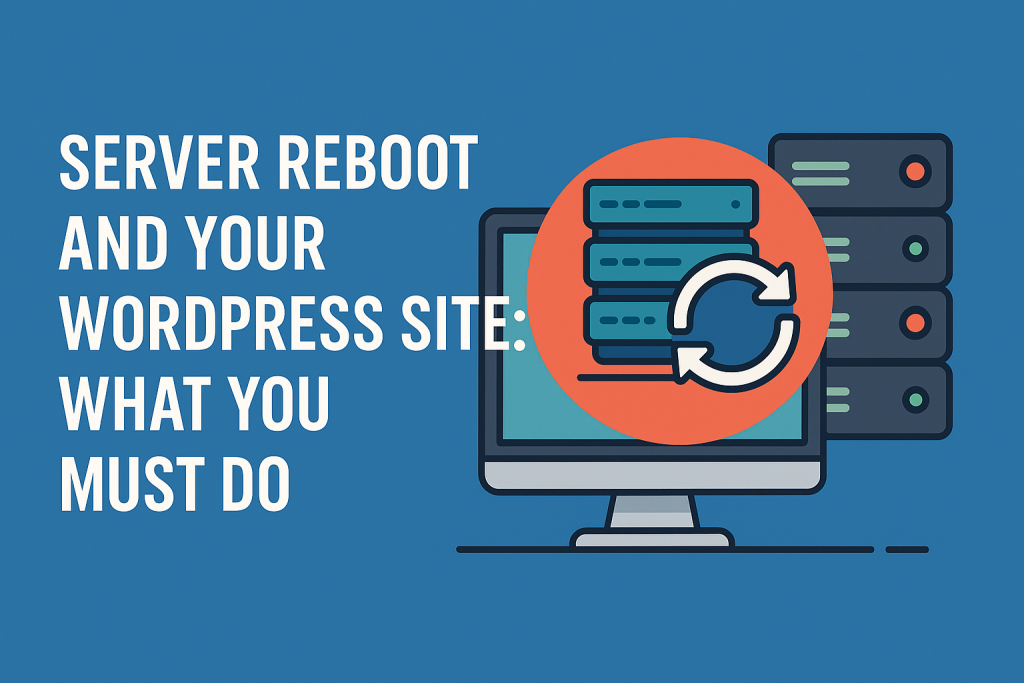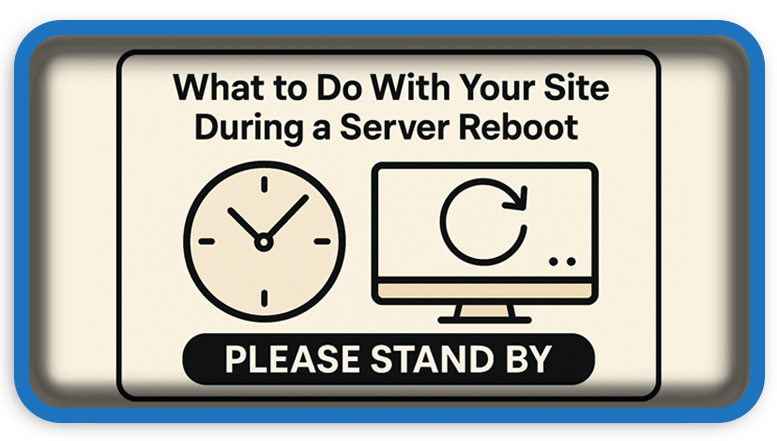⏲️ Estimated reading time: 4 min
A server reboot can lead to temporary downtime of your WordPress site. To avoid data loss or prolonged offline time, it’s crucial to follow essential steps before and after restarting your server.
🔁 What to Do With Your Site During a Server Reboot. Website downtime can hurt both user experience and SEO. That’s why preparing properly for a server reboot and knowing what to check afterwards is vital for any WordPress administrator or VPS owner. This article walks you through the full checklist to protect your WordPress site during a reboot.
✅ Before Reboot:
1. Create a Full Backup
Never reboot your server without a backup.
- Backup your WordPress files and MySQL database.
- Use plugins like:
- UpdraftPlus
- All-in-One WP Migration
- Or create manual backups via cPanel, hPanel, or SSH.
This ensures you can restore your site if something goes wrong.
2. Notify Visitors (Optional)
If you expect your site to go offline during the reboot:
- Activate Maintenance Mode using plugins like:
- WP Maintenance Mode
- SeedProd
- Customize the message to explain the temporary downtime.
This prevents a confusing experience for your users and preserves professionalism.
3. Check Uptime Monitoring
Be proactive by enabling monitoring:
- Services like UptimeRobot, Jetpack Monitor, or Better Uptime can notify you instantly if your site is offline.
- Set up alerts via email, SMS, or Slack.
This way, you’re the first to know if something’s wrong.
4. Temporarily Disable Critical Tasks
Before rebooting:
- Disable
wp-cron.phptemporarily or pause external cron jobs. - Pause caching systems to avoid corruption or errors:
- WP Rocket
- LiteSpeed Cache
- Object caching tools like Redis or Memcached

🔄 After Reboot:
1. Ensure the Server Booted Correctly
Use your control panel (like cPanel, hPanel, or Plesk) or log in via SSH to verify services:
sudo systemctl status nginx
sudo systemctl status mysql
sudo systemctl status php-fpm
If any of these services failed to start, you may experience a white screen or 500 error on your WordPress site.
2. Check If the Site is Live
- Open your website in a browser.
- Look for HTTP 200 (OK) status.
- Common problems after reboot:
- White screen (WSOD)
- HTTP 500 errors
- “Error establishing a database connection”
3. Restart WordPress Services If Needed
If your website isn’t loading:
sudo systemctl restart nginx
sudo systemctl restart php-fpm
sudo systemctl restart mysql
These three services are essential for WordPress to run.
4. Reactivate Caching and Cron Jobs
- Re-enable any caching plugins.
- If you’re using an external cron manager (like crontab -e), restart it and check logs.
Make sure wp-cron.php is triggered correctly if you disabled it previously.
5. Check Server Logs for Errors
Use SSH or your hosting panel to check for issues:
tail -f /var/log/nginx/error.log
tail -f /var/log/mysql/error.log
tail -f /var/log/php8.x-fpm.log
These logs will give you real-time feedback about issues like misconfigured plugins, memory limits, or PHP fatal errors.
6. Test Emails and Forms
- Submit a contact form to test email delivery.
- Use WP Mail SMTP to ensure that email functionality is restored and authenticated (especially if your server uses SMTP relays).
7. Scan for Security or Permission Issues
A reboot might alter file permissions.
Run these commands to reset them correctly:
sudo chown -R www-data:www-data /var/www/html
sudo find /var/www/html -type d -exec chmod 755 {} \;
sudo find /var/www/html -type f -exec chmod 644 {} \;
This avoids permission-denied errors when uploading media or installing plugins.
🔒 Bonus: Automate Uptime Monitoring
Consider using automated tools that run periodically and alert you when:
- Your site is down.
- Response time is slow.
- HTTP errors persist.
Some tools even offer server restart automation, SSL checks, and API integration with Slack, Telegram, or Discord for alerts.
🧩 What If Your Site Doesn’t Come Back?
If your WordPress site remains offline after all the checks:
- Check
wp-config.phpfor misconfigurations. - Inspect
.htaccessfor redirect loops. - Disable all plugins via FTP by renaming
/wp-content/plugins/.
You may also contact your host to verify if the server’s DNS, IP, or firewall rules changed during reboot.
🧠 Tech Admin Tip
Always schedule server reboots during low-traffic hours and document your process. Using a runbook (step-by-step plan) for reboots minimizes downtime and ensures a smooth recovery.
🔚 Final Thoughts
Rebooting a server doesn’t need to be a high-risk event. By preparing carefully, checking core services, and performing post-reboot maintenance, your WordPress site can stay secure, live, and fully operational.
🔔 For more tutorials like this, consider subscribing to our blog.
📩 Do you have questions or suggestions? Leave a comment or contact us!
🏷️ Tags: server reboot, wordpress server, uptime, site maintenance, cron jobs, wordpress backup, server errors, nginx restart, php-fpm, mysql restart
📢 Hashtags: #ServerReboot, #WordPressTips, #BackupWebsite, #SiteMaintenance, #UptimeMonitor, #RestartServer, #WordPressSupport, #DowntimeFix, #SiteOffline, #AdminTools
Only logged-in users can submit reports.
Discover more from HelpZone
Subscribe to get the latest posts sent to your email.

